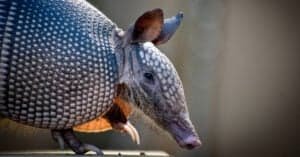Armadillos are cute and curious animals who happen to be armored like some kind of ancient warrior. They’re fascinating.
Not only are they intriguing to look at, but they’re also unique individuals. There are over 20 species of armadillo, and each species produces unique individuals who are entitled to a life that suits them.
This begs the question — “is it okay to keep armadillos as pets?” The answer to this question depends on a number of things, all of which will be covered in this article.
Do people keep armadillos as happy pets? Yes.
Should everyone have an armadillo? No.
Let’s dig into the specifics about keeping an armadillo as a pet, what’s required, and whether or not they make good pets.
What are Armadillos & Are They Friendly?
Armadillos are a group of mammals with 21 unique species. They can be only a few inches long such as the elusive pink fairy armadillo, or grow to nearly 120 pounds like the giant armadillo.
In all cases, these critters are united by their signature shells — leathery defenses against predators. Very few mammals possess these types of shells, and that’s part of the reason that the armadillo is such a visually distinctive animal.
They fall somewhere between an opossum and a turtle, but most people don’t know much about them. It’s important to know that armadillos are relatively solitary creatures and they don’t typically do any harm to people or other pets.
They do have strong claws used for digging, but those won’t be swiped at you unless you’re being reckless or forceful with a wild armadillo. It’s advisable to leave wild armadillos (and all wild animals) alone because they are capable of defending themselves.
Armadillos can bite as well, and they’re known to carry rabies, leprosy, and other diseases. That’s right, the nine-banded armadillo is known to carry leprosy.
That said, pet armadillos are mostly very sweet, a little suspicious, and extremely cute. While we can’t say they’re objectively friendly, they definitely have the potential to be.

Armadillos are relatively solitary creatures and they don’t typically do any harm to people or other pets.
©iStock.com/Saddako
Is It Humane to Keep Armadillos as Pets?
Armadillos are not domesticated animals. In other words, they won’t naturally behave well in the context of humans simply because they’re raised among humans.
They haven’t been bred in any specific ways, so they still have all of the traits that they evolved with. A domesticated dog is very likely to be friendly, adoring, loyal, and kind because those traits have been selected for by humans for thousands of years.
There’s no telling with an armadillo, on the other hand. One born in captivity and raised around humans might be more likely to behave well, but it’s still a wild animal. Many people live with wild animals as pets, but that comes with the risk of errant behavior.
The next thing to consider is the sort of habitat an armadillo needs in order to have a fulfilling life. You should never own an animal for which you can’t provide adequate habitat. That is inhumane.
In order to provide a healthy habitat, you need to know how they live in nature, which we’ll discuss next. Armadillos are a handful when you think of them in terms of responsible ownership. There’s a lot to take care of, and it could get costly.
Let’s look at the things you need to ensure before you take home a pet armadillo.
An Armadillo’s Needs
Armadillos generally live alone and enjoy a range of roughly 8 acres when they’re out in the wild. Further, they spend most of their waking hours in the dark.
These nocturnal animals originated in South American tropical and subtropical climates. The farthest north the nine-banded armadillo has been found is southern Nebraska, although that’s not its preferred habitat. Armadillos have low body temperatures and they require relatively warm environments in order to thrive.
If you’re someone who lives in the upper-midwestern United States, for example, keeping an armadillo on your property would be unethical. Your armadillo wouldn’t be able to go outside for long periods of time without contracting frostbite or worse.
Armadillos also need room to burrow and dig in search of bugs. This is what they’re born to do, and the process of doing it is natural to them. If you plan to keep an armadillo as a pet, you must be willing to sacrifice that perfectly green lawn.
Their burrows can be dozens of feet long with various entrances and channels, rooms, and even visitors. That’s right, armadillos will allow some other animals to live in their burrows!
Even if you don’t permit your pet to dig extensive tunnel systems, you still have to be willing to let them dig some form of a burrow. You can also expect your armadillo to dig at your floors while you’re not looking.
Digging is how they forage insects and worms as well. They’ll eat a lot of other things, but they’re natural bug-eaters and their digging habits reflect that.
If you’re still considering owning an armadillo, let’s look at what you’ll need.

Armadillos need room to burrow and dig in search of bugs.
©Photo by Michael Overton, CC BY-SA 3.0, via Wikimedia Commons – License
What You Need to Own a Healthy Armadillo
The first thing you’ll need is some form of outdoor enclosure. This enclosure should provide both light and dark places to recline as well as a healthy substrate of dirt to dig through.
The larger, the better. Remember that armadillos usually roam roughly 8 acres or more in the wild. According to Pet Keen, an armadillo needs “20 square feet of space for every foot long it is.”
Ideally, you’ll have the enclosure somewhere with soft earth for your armadillo to dig through. If not, you will need to provide some kind of man-made container holding a soft substrate. Owning an armadillo without providing digging and burrowing opportunities is inhumane, so this is a requirement.
The enclosure should also include a bathing pool for the animal to cool itself down or simply bask when it wants to.
Day-to-Day Responsibilities
If you have a healthy enclosure for your pet and you live in the right climate for an armadillo, there aren’t too many additional responsibilities you’ll need to take care of. Naturally, you have to feed and water the animal, but armadillos take care of a great deal of their own grooming, entertainment, and more.
Armadillos aren’t known to be trainable. They’ll likely be inclined to do their own thing for the majority of the time you own them. If you socialize the animal well, it might be cuddly and affectionate towards you, although there’s no guarantee.
Odds are that it will kind of stick to itself and rely on you for food more than affection.
Other Considerations for Pet Armadillos
One positive aspect of pet armadillos is that they can eat a lot of different foods. Many owners offer them dog or cat food to supplement their bug consumption. They’re omnivores, and they’re famous for getting into garbage in the wild.
That’s not to say that they should eat garbage, but only that they’re not too picky when it comes to food.
Another thing to consider is that this is an animal that requires a unique investment of time and money. You are responsible for monitoring and caring for the animal in a unique outdoor enclosure that you create. Further, you have this responsibility for 4-30 years depending on the species.
Captive armadillos can live up to three decades. They will spend most of that time in their network of burrows, sleeping upwards of 15 hours per day. Then, they will come out at night to wander, eat bugs, and explore.

Captive armadillos can live up to thirty years depending on the species, so the commitment to their care is very long-term.
©Klaus Balzano/Shutterstock.com
So, Do They Make Good Pets?
If you’re acquiring an armadillo from a rescue or you’ve found one that can’t be released back into the wild, it could be a great pet.
You and your armadillo will probably get along great for the next 30 years, minding your own business and having the occasional bonding moment. That cute little armored face will gaze back at you and appreciate you from time to time, no doubt.
Still, armadillos don’t make the best pets for most people. They’re nocturnal, they don’t have a natural affinity for humans, they spend most of their time sleeping, and they’re a huge responsibility that could last for decades.
Our suggestion is that you only buy an armadillo if you’re truly confident you can uphold that responsibility for the long haul! If that’s the case, you’ll have the cutest and most unique pet around.
The photo featured at the top of this post is © iStock.com/6381380
Thank you for reading! Have some feedback for us? Contact the AZ Animals editorial team.






